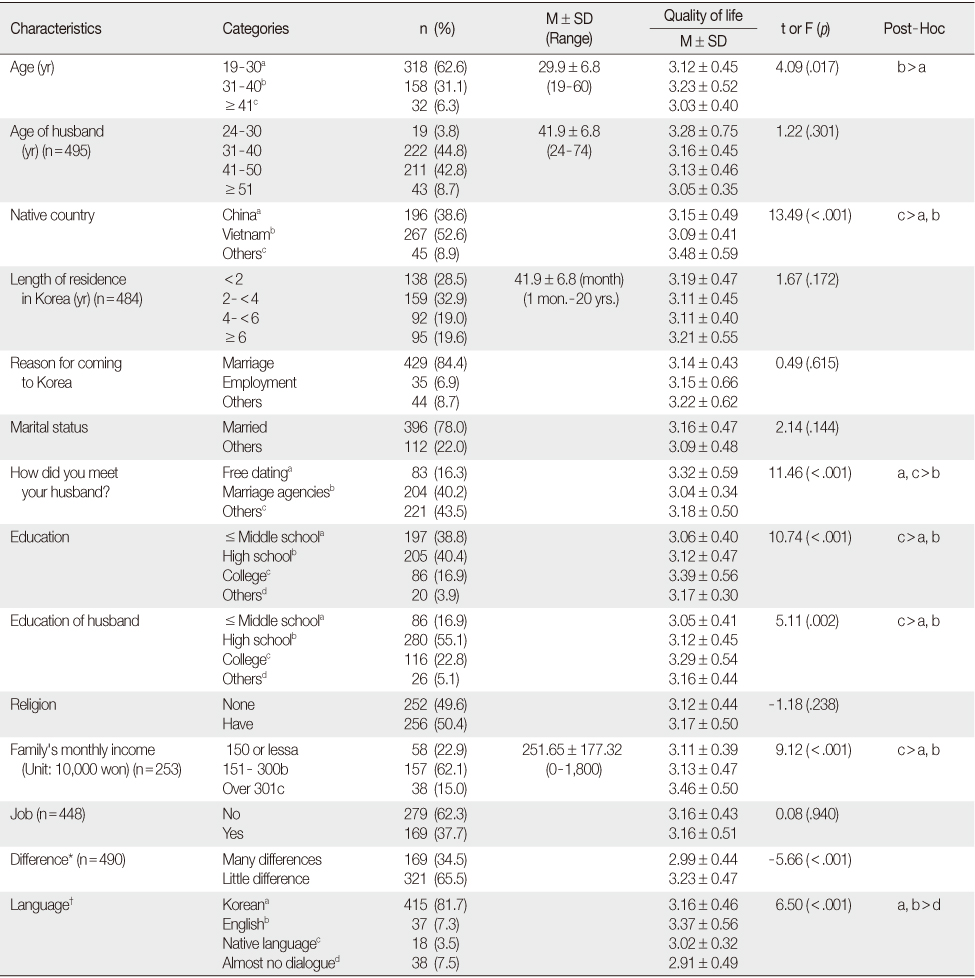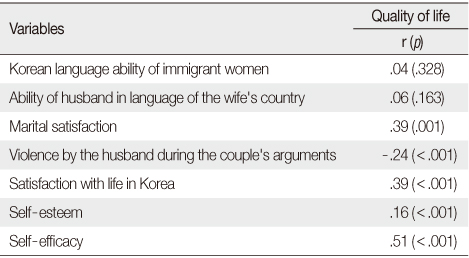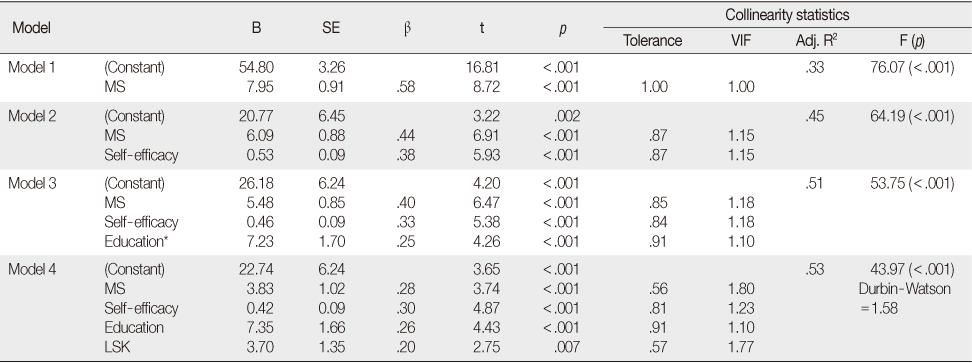Articles
- Page Path
- HOME > J Korean Acad Nurs > Volume 42(2); 2012 > Article
-
Original Article
- Factors Influencing Quality of Life in Married Immigrant Women in Korea
- Eun Kwang Yoo, Hye Jin Kim, Myoung-Hee Kim
-
Journal of Korean Academy of Nursing 2012;42(2):171-180.
DOI: https://doi.org/10.4040/jkan.2012.42.2.171
Published online: April 30, 2012
1Professor, Department of Nursing, Hanyang University, Seoul, Korea.
2Lecturer, Department of Nursing, Hanyang University, Seoul, Korea.
3Associate professor, Department of Nursing, Semyung University, Jecheon, Korea.
- Address reprint requests to: Kim, Myoung-Hee. Associate professor, Department of Nursing, Semyung University, 579 Sinwol-dong, Jecheon-si, Chungbuk, Korea, 390-711. Tel: +82-43-649-1352, Fax: +82-43-649-1785, H.P: +82-10-4049-3964, mh1352@semyung.ac.kr
© 2012 Korean Society of Nursing Science
- 817 Views
- 3 Download
- 10 Crossref
Abstract
-
Purpose
- The purpose of this study was to identify the factors influencing quality of life of married immigrant women in Korea.
-
Methods
- The participants included 508 married immigrant women who met the eligibility criteria and agreed to participate in the study. Participants were evaluated for subjective assessment of married immigrant-related constructs using a self-report questionnaire, for self-esteem, self-efficacy, and quality of life (QOL). The analysis was done using SPSS for Windows, version 10.1, and included stepwise regression.
-
Results
- The major findings were as follows; 1) There were significant relationships between marital satisfaction (r=.39, p=.001), violence by the husband during the couple's arguments (r= -.24, p<.001), satisfaction with life in Korea (r=.39, p<.001), self-esteem (r=.16, p<.001), self-efficacy (r=.51, p<.001) and quality of life. 2) Marital satisfaction, self-efficacy, education level and satisfaction life with in Korea were significant factors, which explained 53% of the variance in quality of life (F=43.97, p<.001). Multiple regression analysis revealed that a powerful predictor of QOL for married immigrant women was self-efficacy.
-
Conclusion
- Developing nursing interventions to enhance self-efficacy toward improvement of QOL among married immigrant women is recommended.
- 1. An H.S., Kim K.S. A comparative study on the quality of life of Korean and Chinese women who are employed and married. Journal of Korean Home Management Association. 2009;27(1):127–144.
- 2. Aro H. Risk and protective factors in depression: A developmental perspective. Acta Psychiatrica Scandinavica. 1994;89(s377):59–64. http://dx.doi.org/10.1111/j.1600-0447.1994.tb05804.x.ArticlePubMed
- 3. Baik H.W. Comparison of psychological character of female university students majoring in dance. 1993;Seoul, Seoul National University. Unpublished master's thesis.
- 4. Bandura A. Self-efficacy: Toward a unifying theory of behavioral change. Psychological Review. 1977;84:191–215. http://dx.doi.org/10.1037/0033-295X.84.2.191.ArticlePubMed
- 5. Bentsen S.B., Wentzel-Larsen T., Henriksen A.H., Rokne B., Wahl A.K. Self-efficacy as a predictor of improvement in health status and overall quality of life in pulmonary rehabilitation-An exploratory study. Patient Education and Counseling. 2010;81:5–13. http://dx.doi.org/10.1016/j.pec.2009.11.019.ArticlePubMed
- 6. Chino B., Nemoto T., Fujii C., Mizuno M. Subjective assessments of the quality of life, well-being and self-efficacy in patientswith schizophrenia. Psychiatry and Clinical Neurosciences. 2009;63:521–528. http://dx.doi.org/10.1111/j.1440-1819.2009.01995.x.ArticlePubMed
- 7. Flaskerud J.H., Uman G. Acculturation and its effects on self-esteem among immigrant Latina women. Behavioral Medicine. 1996;22:123–133. http://dx.doi.org/10.1080/08964289.1996.9933773.ArticlePubMed
- 8. Fry P.S. Predictors of health-related quality of life perspectives, self-esteem, and life satisfactions of older adults following spousal loss: An 18-month follow-up study of widows and widowers. The Gerontologist. 2001;41:787–798. http://dx.doi.org/10.1093/geront/41.6.787.PubMed
- 9. Hong D.A.G., Chae O.H. Family life and conflicts of female international marriage migrant. Journal of the Korean Living Science Association. 2006;15:729–741.
- 10. Hong H.Y. The relationships of perfectionism, self-efficacy and depression. 1995;Seoul, Ewha Womans University. Unpublished master's thesis.
- 11. Jang M.S., Lee O.K. A research on the economic independence of marriage immigrant women in Seoul through the capacity development for employment or businesses. 2009;Seoul, Seoul Foundation of Women & Family.
- 12. Jun H.J., Min S.H., Lee M.Y., Choi H.Y. Path of the variables to migrant women's families' health. Korean Journal of Family Welfare. 2009;14(2):5–27.
- 13. Kim E.K. The factors related to the marital satisfaction of the foreign wives who live in small town. Journal of Korean Home Management Association. 2008;26(6):83–94.
- 14. Kim H.S. Social integration and health policy issues for international marriage migrant women in South Korea. Public Health Nursing. 2010;27:561–570. http://dx.doi.org/10.1111/j.1525-1446.2010.00883.x.PubMed
- 15. Kim K.B., Sok S.R. A comparison of the health and related quality of life between middle-aged Korean and Chinese women. International Nursing Review. 2010;57:463–469. http://dx.doi.org/10.1111/j.1466-7657.2010.00816.x.ArticlePubMed
- 16. Kim S.J. A study of relationship between health promoting lifestyle, depression, quality of life among middle aged women. 2006;Suwon, Ajou University. Unpublished master's thesis.
- 17. Kim S.K., Kim Y.K., Cho A.J., Kim H.R., Lee H.K., Seol D.H., et al. A national survey on multicultural families 2009. 2010;Seoul, Korea Institute for Health and Social Affairs.
- 18. Kim S.Y., Jeon E.Y., Sok S.R., Oh H.K., Kim K.B. Quality of life of Korean and Korean American older adults: A comparison. Journal of Gerontological Nursing. 2009;35(6):28–34.Article
- 19. Kuehner C., Buerger C. Determinants of subjective quality of life in depressed patients: The role of self-esteem, response styles, and social support. Journal of Affective Disorders. 2005;86:205–213.ArticlePubMed
- 20. Kye S.J., Kang H.K., Jeong M.S. The study on the marital life factors for the multi-culture families: Focused on the case study of multi-culture family in Yongsan-Gu. Journal of Korean Family Resource Management Association. 2009;13(3):31–57.
- 21. Mann M., Hosman C.M., Schaalma H.P., de Vries N.K. Self-esteem in a broad-spectrum approach for mental health promotion. Health Education Research. 2004;19:357–372. http://dx.doi.org/10.1093/her/cyg041.ArticlePubMed
- 22. Min S.K., Lee C.I., Kim K.I., Suh S.Y., Kim D.K. Development of Korean version of WHO quality of life scale abbreviated version (WHOQOL-BREF). Journal of Korean Neuropsychiatric Association. 2000;39:571–579.
- 23. Oh S.H., Yoon D.S. A comparative study on quality of life on the elderly among urban, farm and island area. Journal of Welfare for the Aged. 2006;32:119–147.
- 24. Panchanadeswaran S., Dawson B.A. How discrimination and stress affects self-esteem among Dominican immigrant women: An exploratory study. Social Work in Public Health. 2011;26:60–77. http://dx.doi.org/10.1080/10911350903341069.ArticlePubMed
- 25. Rosenberg M. Society and the adolescent self-image. 1965;Princeton, NJ, Princeton University Press.
- 26. Seol D.H. Foreign wives' life in Korea: Focusing on the policy of welfare and health. 2005;Gwacheon, Ministry of health and welfare.
- 27. Sherer M., Maddux J.E., Mercadante B., Prentice-Dunn S., Jacobs B., Rogers R.W. The self-efficacy scale: Construction and validation. Psychological Reports. 1982;51:663–671.ArticlePDF
- 28. Shin S.M. A study on house wives' self esteem, level of the stress perceived and coping style for stress. Understanding People. 2004;25:47–62.
- 29. Strecher V.J., DeVellis B.M., Becker M.H., Rosenstock I.M. The role of self-efficacy in achieving health behavior change. Health Education Quarterly. 1986;13:73–92.ArticlePubMedPDF
- 30. World Health Organization Quality of Life Group. The World Health Organization Quality of Life (WHOQOL) assessment: Position paper from the World Health Organization. Social Science and Medicine. 1995;41:1403–1409. http://dx.doi.org/10.1016/0277-9536-(95)00112-K.PubMed
REFERENCES
Figure & Data
REFERENCES
Citations

- Serial Dual Mediating Effects of Parenting Stress on Life Satisfaction among Parents of School-Aged Children with Chronic Conditions
Jeong-Won Han, Boeun Yang, Hanna Lee
Healthcare.2024; 12(4): 461. CrossRef - Health‐related quality of life among migrant workers: The impact of health‐promoting behaviors
Sunghye Cho, Hyeonkyeong Lee, Eui Geum Oh, Gwang Suk Kim, Yong‐Chan Kim, Chang‐gi Park
Nursing & Health Sciences.2020; 22(2): 318. CrossRef - Health of International Marriage Immigrant Women in South Korea: A Systematic Review
Jeong-Ah Ahn, Tiffany Kim, Eun Ha Roh, Ju-Eun Song
Journal of Immigrant and Minority Health.2018; 20(3): 717. CrossRef - The Effect of Self-esteem, Stress and Social Support on Fishermen's Quality of Life
Hye Seo Park, Mi Yeul Hyun
Journal of Korean Academy of Psychiatric and Mental Health Nursing.2016; 25(4): 273. CrossRef - An Exploratory Study on Appearance Related Quality-of-Life of Obese Korean Men
Haekyung Yu, Sunyoung Ko
Journal of the Korean Society of Clothing and Textiles.2015; 39(6): 812. CrossRef - Cultural Competence, Health Promotion Behavior, and Quality of Life in Married Immigrant Women in Korea
Myung Sill Chung
The Journal of Korean Academic Society of Nursing Education.2015; 21(1): 36. CrossRef - Analyzing Factors Influencing the Quality of Life in Vietnamese Married Immigrant Women in Korea
Hung Sa Lee, Chunmi Kim, Myung Sook Park
Journal of Korean Academy of Community Health Nursing.2015; 26(3): 268. CrossRef - Comparison of Parenting Stress between Married Migrants and Korean Women
Hae Kyeong Kim, Eun Hee Lee
Perspectives in Nursing Science.2014; 11(2): 101. CrossRef - Influence of Acculturative Stress of Married Migrant Women on Marriage Satisfaction: The Mediating Effect of Problem‐Solving Ability and Information Support
Mijin Park, Byung‐Hyun Park
Asian Social Work and Policy Review.2013; 7(1): 44. CrossRef - Factors Influencing Depression in Married Immigrant Women in Korea
Ju Young Ha, Yoon Ji Kim
Korean Journal of Women Health Nursing.2013; 19(4): 254. CrossRef
Differences of Quality of Life according to Socio-demographic Factors (N=508)
*Difference: Difference in husband's character between before and after marriage; †Language: Language used for chatting with husband.
Levels of Quality of Life and related Variables
Correlations of related Variables with Quality of Life (N=508)
Regression Equation Values for the Prediction of Quality of Life (N=508)
MS=Marital satisfaction; LSK=Life satisfaction in Korea; Dependent variables=Quality of life.
*Education=Dummy coded (less middle school=000, high school=100, college=010, others=001).
*Difference: Difference in husband's character between before and after marriage; †Language: Language used for chatting with husband.
MS=Marital satisfaction; LSK=Life satisfaction in Korea; Dependent variables=Quality of life. *Education=Dummy coded (less middle school=000, high school=100, college=010, others=001).
 KSNS
KSNS
 E-SUBMISSION
E-SUBMISSION




 Cite
Cite

